
40-Year Enthusiasm for Energy Storage Batteries
The Struggle to Develop Redox Flow Batteries
Development of redox flow batteries starting from the 1980s
The principle of a redox flow battery was first proposed in 1974 by NASA, USA. Almost at the same time, the National Institute of Advanced Industrial Science and Technology*1 (AIST) launched basic research in Japan. Around 1980, the difference in demand for electricity between day and night started to emerge as an issue with the growing proliferation of air conditioners in Japan. A proposed measure was load leveling, storing oversupply power in the nighttime and using it in the daytime. A national project, the Moonlight Project, was started to develop four advanced energy storage batteries, including redox flow batteries. In this period, Sumitomo Electric was looking for new themes to overcome the tendency to rely on the power cable business. One of the new themes was an energy storage battery. In addition to power generation and transmission, energy storage was thought to be necessary in the future. Thus, a redox flow battery was chosen as a new development theme, which had development issues in materials. It was in 1982 that Toshio Shigematsu, a newcomer at that time, was assigned to develop the battery.
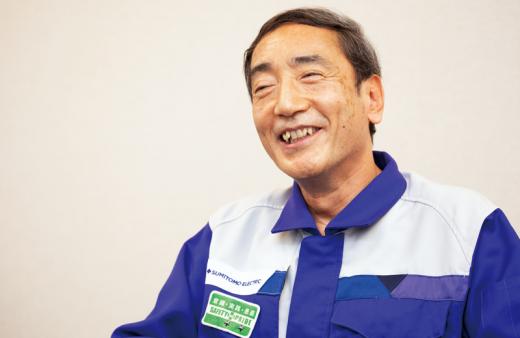
“The Sumitomo Electric Group had no experience in developing a battery and was a complete novice. We were feeling our way in the dark. In this same time period, Kansai Electric Power Co., Inc. also chose a redox flow battery as a research topic and started a joint research and development project with our group. We selected the ironchromium system as an electrolyte and produced a prototype of mini-cells (with an electrode area of 10 cm2) by following the example of others. When we scaled up the prototype, various problems, such as electrolyte leakage and poor performance, occurred. In 1989, we produced a 60-kW redox flow battery (with an electrode area of 3,000 cm2); however, it generated hydrogen gas, which decreased the battery capacity, and the performance could not be maintained in the long run. We could not help but admit that commercialization was difficult in that stage,” said Shigematsu.
However, Shigematsu and other development members did not give up. They tried to use a vanadium electrolyte, which an Australian university proposed. When the developed battery was tested, it achieved high performance in an instant with the help of accumulated cell material techniques. The electromotive force was 1.4 times as large as that of the Fe-Cr electrolyte, the output was doubled, and the energy density was almost tripled. The generated hydrogen gas was extremely decreased. A gleam of light was seen on the way toward commercialization.
*1 Then the Electrotechnical Laboratory
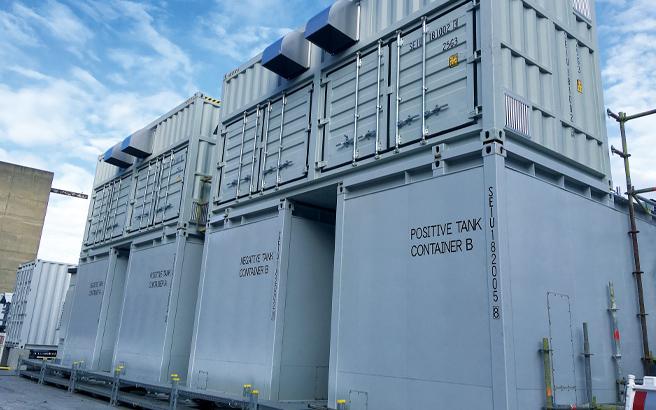
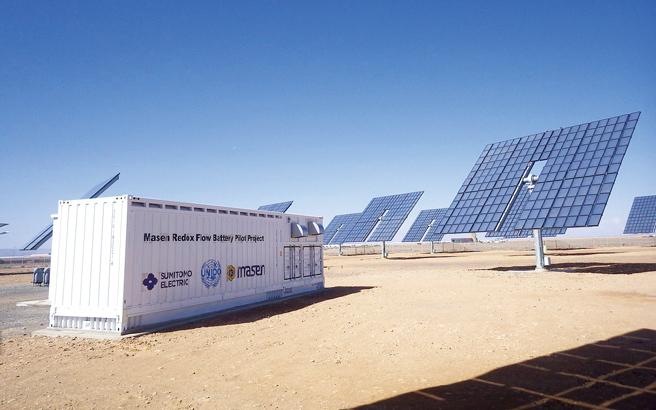
The project returned to life
The circumstances had changed in the latter half of the 1990s, when electricity deregulation had developed and the power rate decreased. Electric power companies changed their course of action. They were installing energy storage batteries at customer sites to sell inexpensive nighttime electricity in terms of effective use of nighttime power. In response to this need, Sumitomo Electric began to deliver redox flow batteries to universities and plants in 2001. However, Shigematsu’s and other members’ hopes were shattered. The redox flow batteries at that time had low durability and suffered from repeated troubles, such as the leakage of an electrolyte. It was difficult to solve these problems, and top management decided to withdraw from the redox flow battery business in 2005. After that, the members had to focus on troubleshooting.
The tide began to turn in 2009. The US proposed the Green New Deal initiative, and large-capacity storage batteries were required to store renewable energy. In Japan, a movement toward renewable energy was growing. While winding down the business, such as removing facilities, they were trying to find the causes of past problems and implement measures. Katsuya Yamanishi said that he felt the time was ripe.
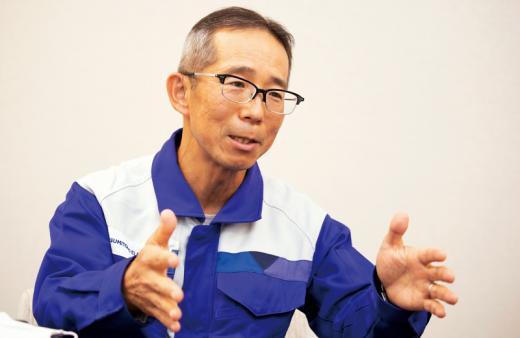
“Withdrawing from the redox flow battery business was nothing more than frustration. While the circumstances surrounding energy had greatly changed, we continued to appeal to top management to resume the redox flow battery business, saying that it would contribute to the business expansion of Sumitomo Electric. As a result, the redox flow battery business was started again, and we resumed full-scale research and development in 2009. The most important research topic was to maintain the long-term reliability of cell stacks. We had developed materials to exploit the full potential of the batteries, as well as eliminated the electrolyte leakage,” said Yamanishi.
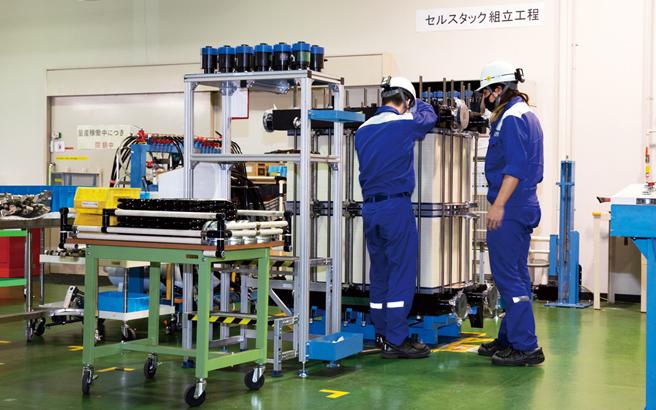
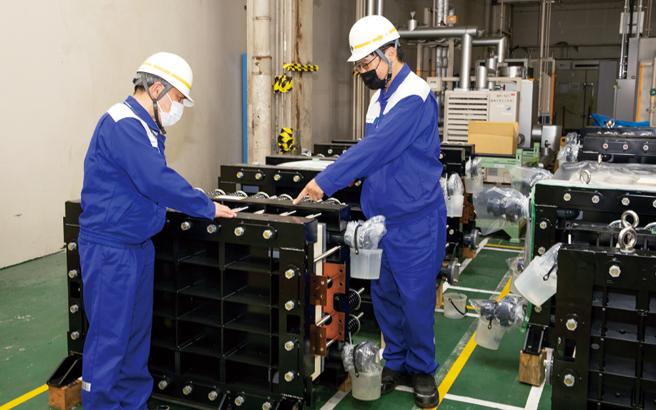
Developing a new electrolyte to achieve higher output
In 2012, a 1,000-kW test system was constructed at the Yokohama Works, and verification tests of developed techniques were conducted. The facility was well received and encouraged dialogue with the markets. This verification led to a real-scale demonstration test at Hokkaido Electric Power Co., Inc (HEPCO) in 2015, funded by the Agency for Natural Resources and Energy, a demonstration project, the New Energy and Industrial Technology Development Organization (NEDO) project in California, USA, and adoption of redox flow battery systems by HEPCO Network.
Aggressive attempts to improve redox flow batteries are still being made at the same time. The most serious issue is a price that customers can accept. To reduce the costs, they are trying to increase output and energy density and are developing an inexpensive electrolyte.
The important factor in cost reduction is output power improvement. The key is cell stacks. The aforementioned Yamanishi and other members are making efforts to increase output power for performance improvement.
“We are improving materials for electrodes and membranes and developing a cell structure that can reduce pressure loss during electrolyte circulation to increase output power. Electrolyte development and higher output power are two sides of the same coin. We aim to develop materials for cell stacks and a structural design that are optimum for the characteristics of an electrolyte. In addition, it is necessary for cost reduction to downsize the container, considering the whole system in the big picture, such as an integrated storage system for components. We also aim to develop a system using a total optimization method,” said Yamanishi.
They are also concentrating on developing an inexpensive new electrolyte for next-generation systems. Tou Youyou has been developing a new electrolyte since joining the Company.
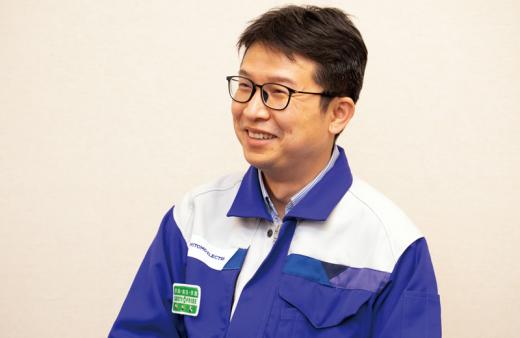
“Currently used vanadium is expensive and has various issues, such as a price fluctuation risk and uneven resource distribution. We are striving to produce a high-performance redox flow battery comparable to a vanadium-system battery, using less expensive and reliably available materials for an electrolyte,” said Tou.
The quest for redox flow batteries is endless.
NEXT
Grid Storage Batteries for Power Supply Stabilization
– Minami-Hayakita Substation, Hokkaido Electric Power Network –
Registration of public notification
If you register your e-mail address, we will notify you when the latest issue is published. If you wish, please register from the registration form.
To delete your registration, please visit here.
